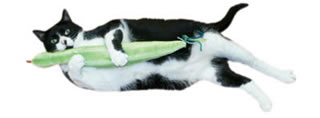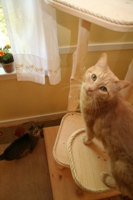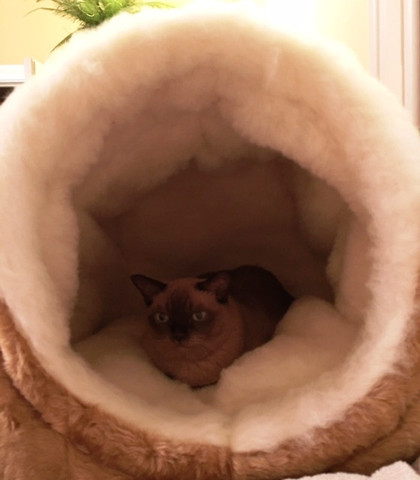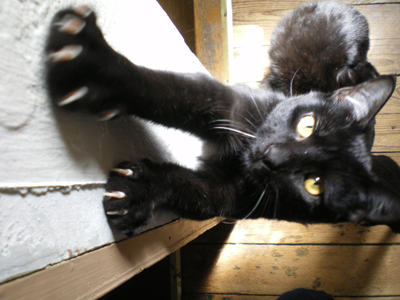In these gray, cold, winter months, we’re always looking for ways to lighten up our spirits. We should also keep our cats’ well being in mind. Cats are intelligent, athletic creatures, always looking for physically and mentally stimulating activities. When cats don’t have these, their attention turns to activities of their own choosing that we tend to think of as “bad behaviors”.
Case in point: Have you ever caught your cat chewing or scratching something like your favorite upholstered chair? Bad behavior = BOREDOM!
Here’s how you can make sure your cat has plenty of great things to do.
- Provide a variety of ways for your cat to explore. Cats love discovering new places and objects. They love smaller, stimulating toys. There are smaller toys you can lay around the house, such as catnip-infused toys, with feathers, strings, corrugated cardboard, suede and other safe, chewable and kickable parts.
Then there are the interactive toys, automated toys designed to be activated by your cats, using their own curiosity and intellect. Some of these toys can be suspended on doors, such as the Fling-ama-String, Play N Squeak Batting Practice, or the Tiger Mobile toy. Others lie flat on the floor, with balls and other moving parts, such as our Cat Hurricane, Peek N Prize, Cats Meow Undercover toy and Kitty Go Round toy.
- Provide your cats access to levels other than just the floor. Cats love climbing to high places and feeling like they are “in charge” of their environment. Having a higher vantage point for your cats to watch the great outdoors (safely) or observe indoor goings-on provides hours of entertainment. Cat trees and cat window perches are great solutions. Place cat trees by windows for your cats’ optimal viewing pleasure. SIDE BENEFIT: Cat trees are made with scratch-able materials such as sisal. They really do use these vertical scratching surfaces, and it helps to keep them from scratching that favorite upholstered chair.
- Provide hideaways for your cat. Cats love discovering places to hide. Think of times when you’ve had to search for your cat, only to find him under the bed, behind the furnace, or in other unfortunate places. Invest in a cat condo that is designed especially to meet the privacy needs of your cats. You’ll be able to find them as well!
- Play with your cat. In your cat’s mind, it’s their favorite
kind of play. During daily play sessions with you, your cat can enjoy a greater degree of intellectual stimulation and aerobic activity. In particular, consider activities that allow your cat to exercise her hunting instincts. Toys that resemble prey, such as mice and birds, are ideal. Wand toys offer a perfect way for you to lure your cat into “the thrill of the chase”.
We’ve also taught our cats some fun tricks, such as fetching toy balls. The toy ball should be light weight and small, such as a Loopies toy or a tinsel mouse. Reward your cats with their favorite treats to encourage repetition.
Now, go make your cat happy!





 A healthy cat will eat what you give her, a kitty who is a little under the weather may need some persuasion; we won’t be talking about those manipulative and overly dramatic “finicky” kitties here. We’re considering cats who are recovering from illness or injury or who are elderly, and for whom even eating is a little bit of a burden. She may seem hungry, even show up for mealtime, but take a sniff or even attempt to eat and walk away. Often illness, surgery, trauma or age reduce a cat’s appetite through weakness, stomach upset, loss of smell or loss of taste, and a cat in a slightly weakened condition may need some inspiration for the taste buds. First, wake her up at least 15 minutes before you want to feed her—a sleepy kitty in a weakened condition isn’t ready to eat as soon as she wakes up, so pet her and give her attention for a while until she seems entirely alert. Always use fresh food, usually canned, so its smell is the strongest, and you don’t need to resort to fish-based foods, often liver-based food is more appealing. Then tease her with the food—play “kitty airplane” the same way you would with a recalcitrant child, show her the can and her dish, open the can and let kitty sniff the food then put it aside, making a big show of getting her dish ready, putting the food in the dish, allowing her to smell it all the while, then finally present it. This little play helps to get her digestive system started and her body gives her the signal to eat, plus, she’s wondering what they heck you’re up to, and curiosity is a big stimulant for a cat. If she’s still reluctant, pick up a little in a spoon and offer it for her to lick off; a little at a time is sometimes just enough. Don’t leave her food out, but put it back in the can and keep it, offering it again a little later. It may mean wasting a few cans, but open a new can with every session. She’ll appreciate your efforts.
A healthy cat will eat what you give her, a kitty who is a little under the weather may need some persuasion; we won’t be talking about those manipulative and overly dramatic “finicky” kitties here. We’re considering cats who are recovering from illness or injury or who are elderly, and for whom even eating is a little bit of a burden. She may seem hungry, even show up for mealtime, but take a sniff or even attempt to eat and walk away. Often illness, surgery, trauma or age reduce a cat’s appetite through weakness, stomach upset, loss of smell or loss of taste, and a cat in a slightly weakened condition may need some inspiration for the taste buds. First, wake her up at least 15 minutes before you want to feed her—a sleepy kitty in a weakened condition isn’t ready to eat as soon as she wakes up, so pet her and give her attention for a while until she seems entirely alert. Always use fresh food, usually canned, so its smell is the strongest, and you don’t need to resort to fish-based foods, often liver-based food is more appealing. Then tease her with the food—play “kitty airplane” the same way you would with a recalcitrant child, show her the can and her dish, open the can and let kitty sniff the food then put it aside, making a big show of getting her dish ready, putting the food in the dish, allowing her to smell it all the while, then finally present it. This little play helps to get her digestive system started and her body gives her the signal to eat, plus, she’s wondering what they heck you’re up to, and curiosity is a big stimulant for a cat. If she’s still reluctant, pick up a little in a spoon and offer it for her to lick off; a little at a time is sometimes just enough. Don’t leave her food out, but put it back in the can and keep it, offering it again a little later. It may mean wasting a few cans, but open a new can with every session. She’ll appreciate your efforts.